First came Engagement Chicken, and then Marry Me Chicken, and now? Well, you know.
Prep: 20 mins
Cook: 60 mins
Total: 80 mins
Servings: 4 servings
Yield: 4 servings
After Engagement Chicken and then Marry Me Chicken came (at least for me) divorce. The idea for this divorce chicken was born from an irreverent reply I gave when someone brought up the forever-trending marry me chicken recipe. This recipe I developed over time mostly so I could have a counter-point to the wedding bell bird.
The flavors of this, my Divorce Chicken, are inspired by some of the travels I did in the wake of my divorce. You can thank my Eat, Pray, Love journey for this one.
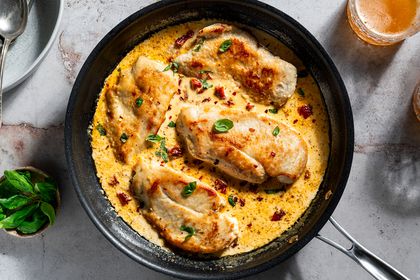
A whole chicken is roasted in a very Moroccan-inspired spice paste that includes the warm notes of cinnamon and cumin. It is cast iron roasted because you may have lost your sheet pans or roasting tray in the divorce, but that shouldn't slow you down from making this comfort food. The carrot salad is a round-the-world (but most especially the South East Asia part) dream loaded with fresh herbs, citrus, and laced with spicy Korean gochujang. And, unlike marriages, this recipe will work out more than 50% of the time.
The only equipment you need to make this recipe are what I also consider to be my top five kitchen tools. These are what you should shop for immediately upon getting your own place, or, better yet, ask for on a divorce gift registry (it's not a thing, but it very much should be a thing).
5 Tools Your Kitchen Needs: Divorce Edition
Chef’s Knife: invest in a good one and you’ll only need one (’til death do you part, but actually)
Cutting Board: plastic or wood, this is a non-negotiable to getting anything done in the kitchen
Cast Iron Pan: it moves from stove-top cooking to oven-roasting effortlessly, plus it’s affordable
Microplane: zesting citrus, grating garlic or Parm cheese this is the tool I reach for most
Veggie Peeler: opt for a Y shaped one, so you aren’t regretting yet another life choice you made
I wanted a whole roasted chicken for this recipe because it's enough to serve four, so you can feel free to invite over a few close friends to celebrate the sanctity of your new-found-happiness (I promise you'll get there) or to bring to someone you know going through their own separation. Alternatively, if you're still in the throws of it and need your alone time, this roast chicken can be eaten directly over the counter, with your hands, along with a nice, cold glass of *literally any drink* to get you through.
A Couple Chicken Tips
- To make applying the spice mix under the skin of the chicken easier, once you have patted the chicken dry, use your fingers to separate the skin a bit from the breast and leg and thigh meat. Then you can go in with the spice paste and application will be much easier.
- Also, rather than roasting a whole chicken you can prepare this recipe using a quartered chicken or with your favorite chicken parts that are bone in, skin on if you want to avoid the carving process.
Make Ahead
Both the dressing and the spice paste for the chicken can be made up to 4 days in advance and stored in an airtight container in the refrigerator until ready to use.
A Note On Cooking With Fresh Citrus
- Depending on the sweetness of the orange used, you may want to increase the sweetness of the dressing with the addition of a little honey or white or brown sugar. Sweetness helps dampen spice, so it’s also a good trick if you find that the dressing is too spicy for your liking— the addition of a little honey or sugar will help to cut some of the heat.
- Depending on the ripeness of the orange or limes you happen to have, one citrus may yield slightly more or less juice than called for in this dressing recipe. For that reason, it’s always good to buy one or two extra fruits any time a recipe calls for fresh citrus, in case you happened to grab a dried out lime or dud of an orange and need back up.
“This spicy chicken and carrot salad was delicious! Spreading the spice mixture under and on top of the chicken infused it with an intense, savory-sweet flavor. The chicken took on a beautifully burnished color once roasted. The gochujang dressing paired really well with the carrots and herbs. Who knew divorce could be so sublime!” —Diana Andrews
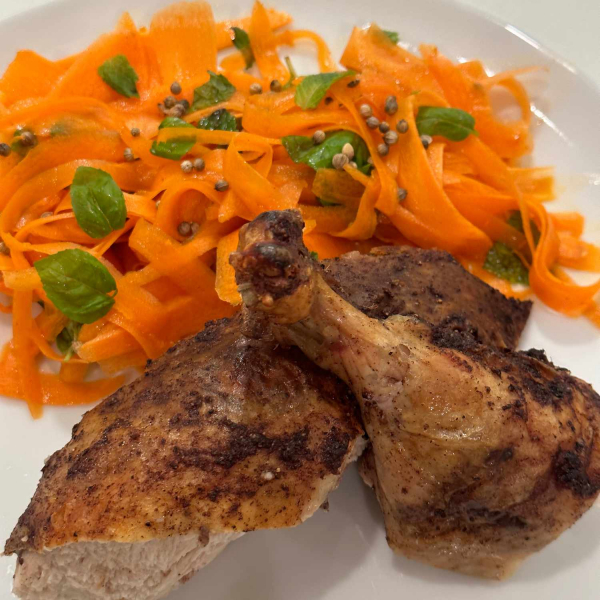
A Note From Our Recipe Tester
Ingredients
For the Chicken:
-
1 tablespoon ground cinnamon
-
2 teaspoons kosher salt
-
2 teaspoons ground cumin
-
1 teaspoon freshly ground black pepper
-
1 tablespoon grated fresh ginger
-
2 tablespoons extra-virgin olive oil
-
1 chicken whole chicken, about 4 to 5 pounds
For the Gochujang Dressing:
-
2 tablespoons gochujang
-
1 navel orange for zesting and juicing (to yield: 1 tablespoon zest + 1/4 cup orange juice)
-
1 lime for juicing (to yield: 1 tablespoon fresh lime juice)
-
1 tablespoon extra-virgin olive oil
-
Kosher salt
For the Carrot Ribbon Salad:
-
5 medium carrots, washed and peeled
-
2 tablespoons coriander seeds
-
1 small bunch mint leaves, torn into pieces
-
1 large handful fresh basil leaves, torn into pieces
-
2 to 3 tablespoons of the gochujang dressing
-
1 to 2 bird’s eye chili cut into thin rounds, optional
Steps to Make It
Make the Chicken
-
Gather ingredients. Position a rack in the lower third of the oven and heat to 425 F.

-
In a small bowl, combine the cinnamon, salt, cumin, pepper, ginger, and oil to form a paste.
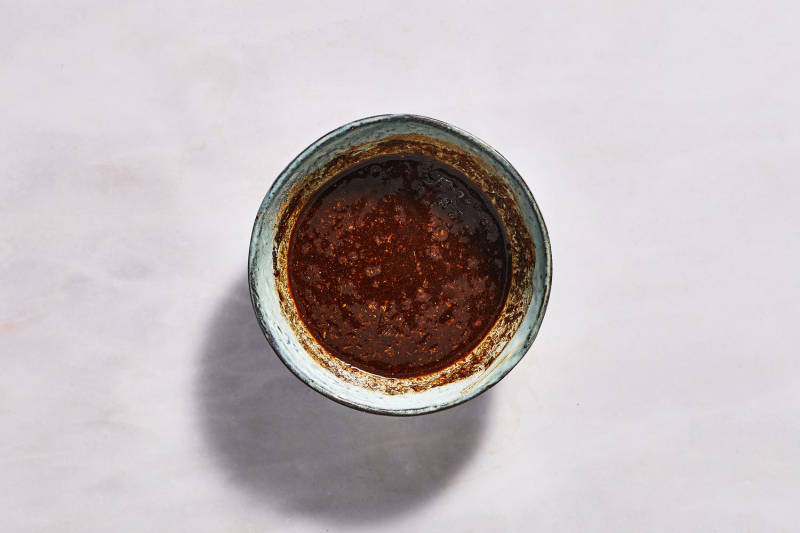
-
Pat the chicken dry all over with paper towels and transfer to a large cast iron skillet or roasting pan, breast side up. Tuck the wings behind the back. If you happen to have kitchen twine, you can also tie the legs together, though trussing the bird is optional.
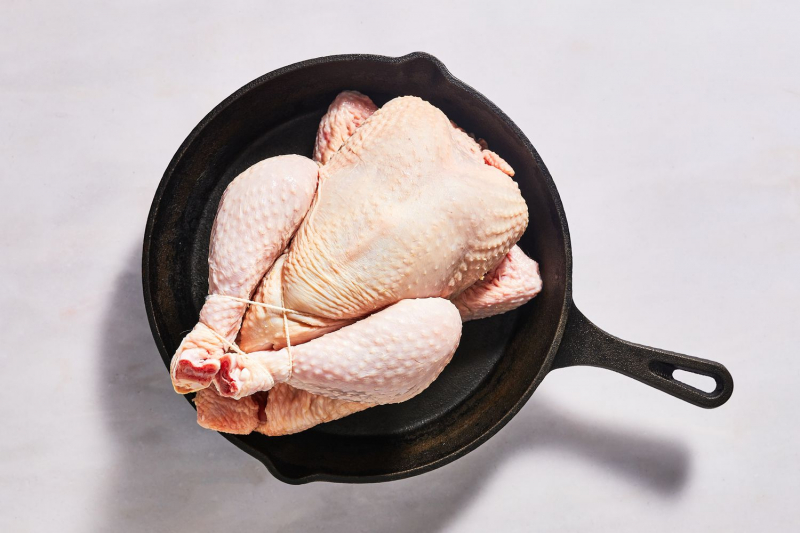
-
Use your fingers to spread the spice paste all under the skin of the chicken as well as the exterior of the bird.

-
Transfer to the oven and roast until a thermometer registers 165 F when inserted in the thigh (be careful not to touch the bone), about 1 hour. Remove from the oven and allow to rest for 10 minutes before carving. Prepare the dressing and carrot salad while the chicken roasts.
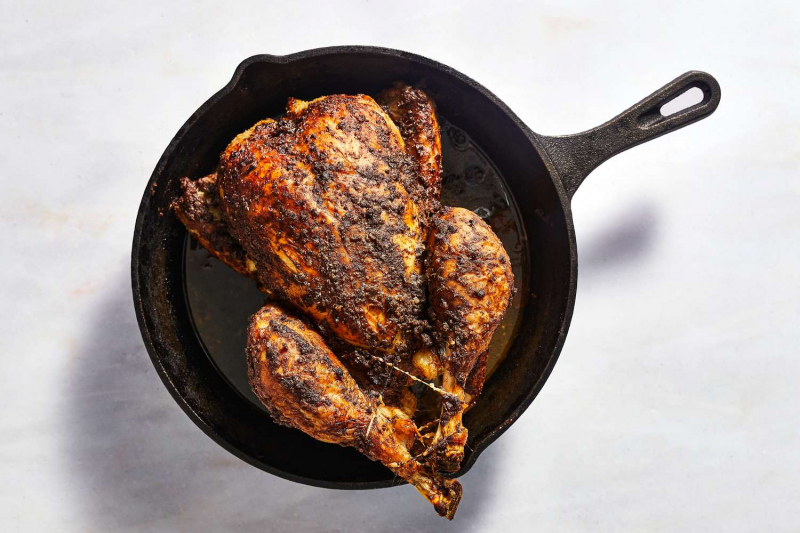
For the Gochujang Dressing:
-
Gather the ingredients.
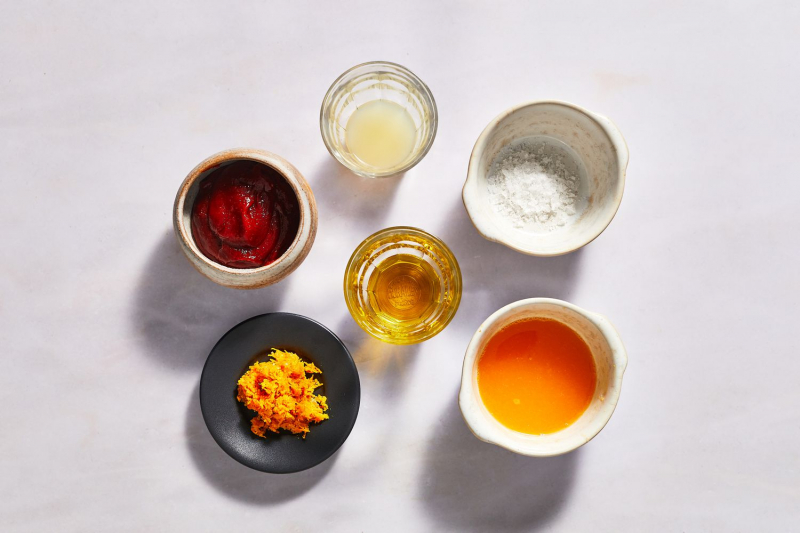
-
In a medium bowl whisk together the gochujang, orange zest, orange juice, lime juice, and olive oil. Season to taste with salt. Set aside.
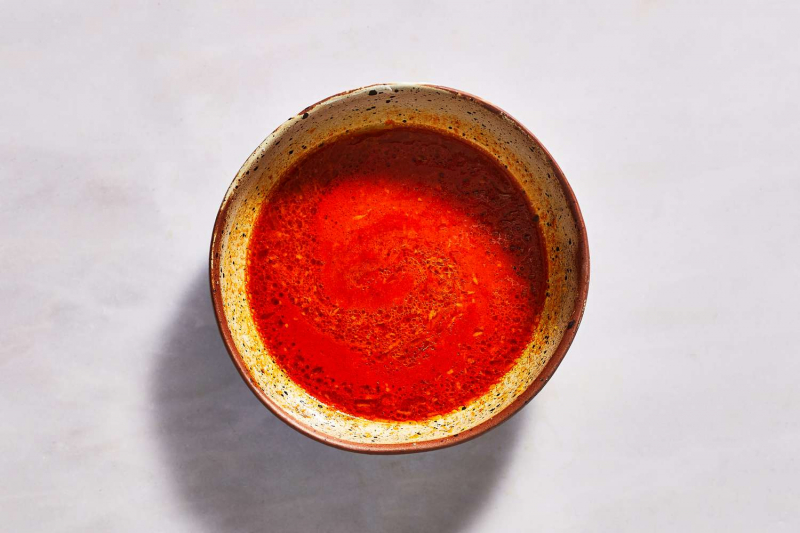
For the Carrot Ribbon Salad:
-
Gather the ingredients.
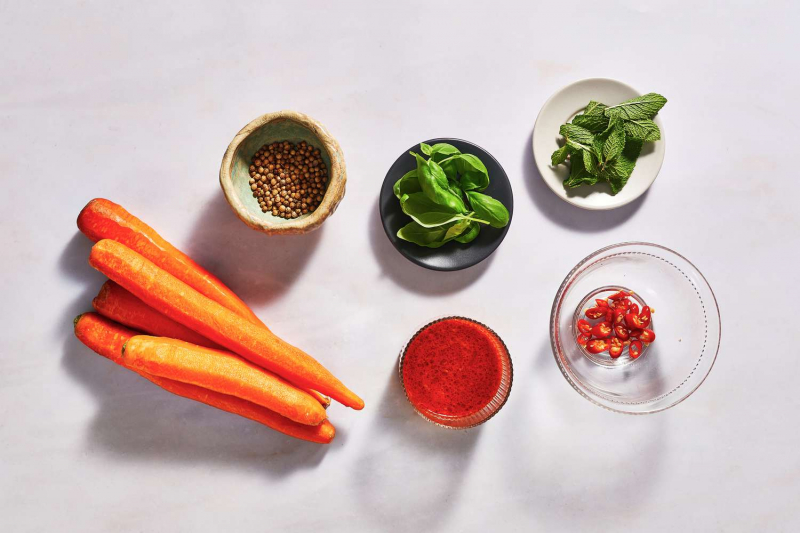
-
In a small skillet over medium heat, toast the coriander seeds, swirling them in the pan until fragrant and toasted, about 1 minute. Transfer to a small bowl and set aside.
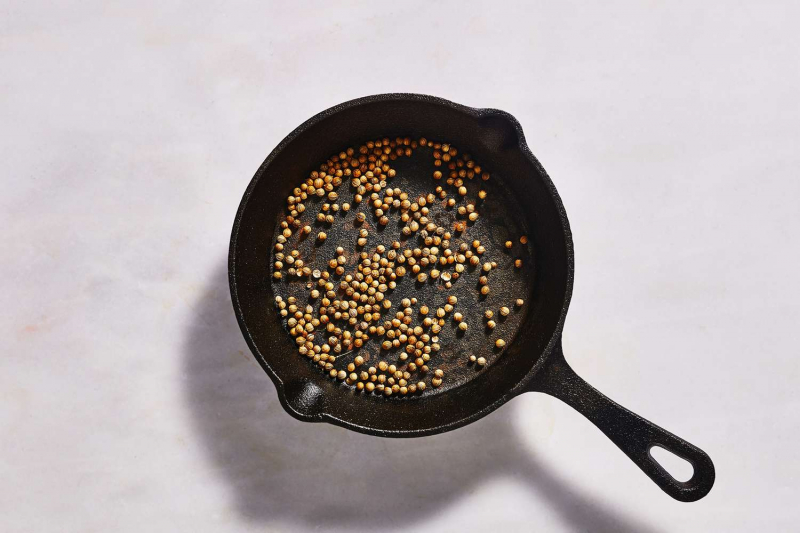
-
Make the carrot ribbons by using a vegetable peeler to cut thin lengthwise slices directly over a large bowl. Add the mint and basil leaves, reserving some for garnish.
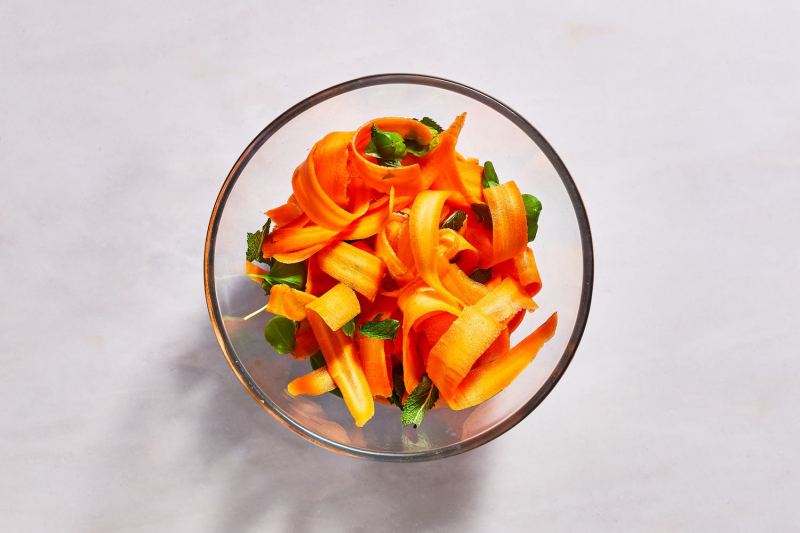
-
When ready to serve, toss the carrots and herbs with 2 to 3 tablespoons of the prepared gochujang dressing. Add more dressing to your taste.
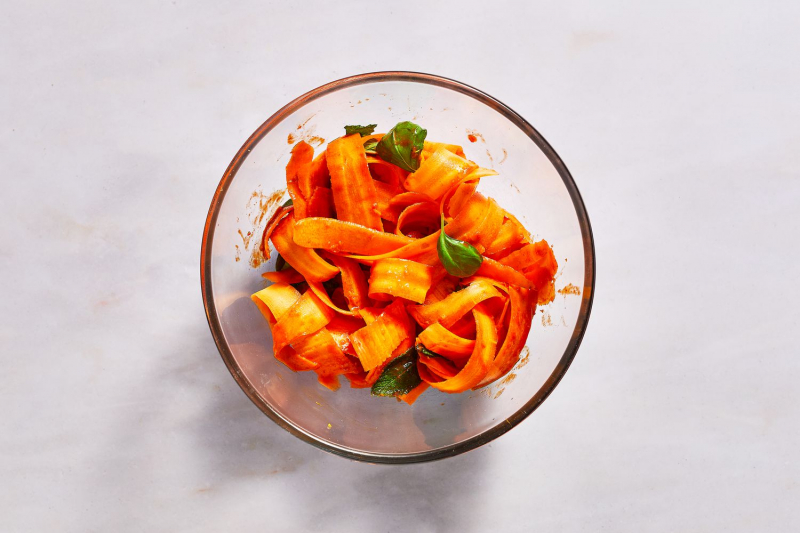
-
Arrange the salad on a large platter. Top with the toasted coriander seeds, garnish with mint and basil leaves, and bird’s eye chili, if using.
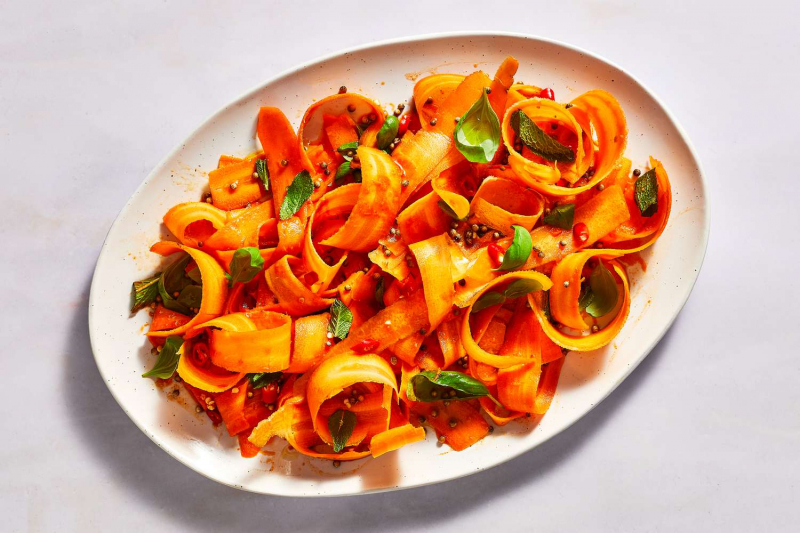
-
When the chicken is done roasting and resting, carve into 8 pieces and serve with the carrot salad and any additional dressing for drizzling and dipping.
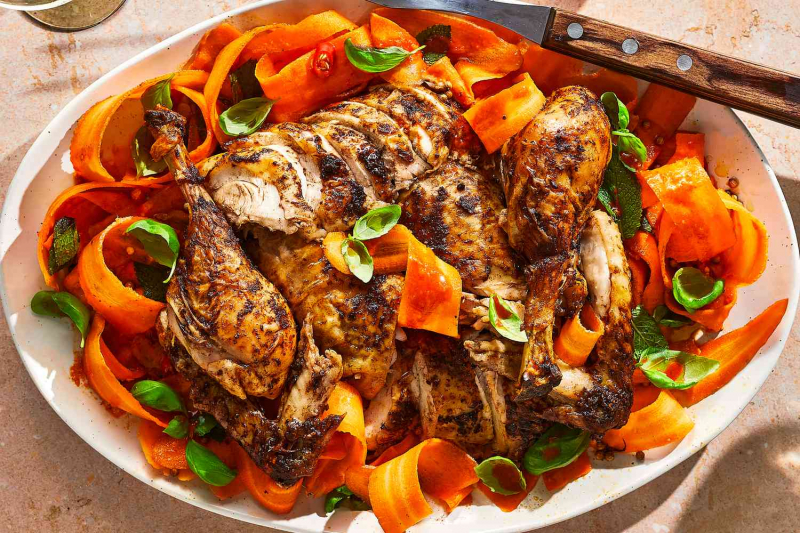
Chicken Breast Variation
Due to the nature of the seasoning paste it will be intense on boneless, skinless chicken pieces if you use it all. If you want to use boneless, skinless chicken breast, adjust to smear only a small, dime sized dollop over each breast and then bake at 425 F for 18 to 20 minutes or until a thermometer registers 165 F.
| Nutrition Facts | |
|---|---|
| Servings: 4 | |
| Amount per serving | |
| Calories | 595 |
| % Daily Value* | |
| Total Fat 34g | 44% |
| Saturated Fat 8g | 40% |
| Cholesterol 152mg | 51% |
| Sodium 1562mg | 68% |
| Total Carbohydrate 24g | 9% |
| Dietary Fiber 5g | 19% |
| Total Sugars 12g | |
| Protein 48g | |
| Vitamin C 32mg | 159% |
| Calcium 120mg | 9% |
| Iron 5mg | 25% |
| Potassium 730mg | 16% |
| *The % Daily Value (DV) tells you how much a nutrient in a food serving contributes to a daily diet. 2,000 calories a day is used for general nutrition advice. | |
